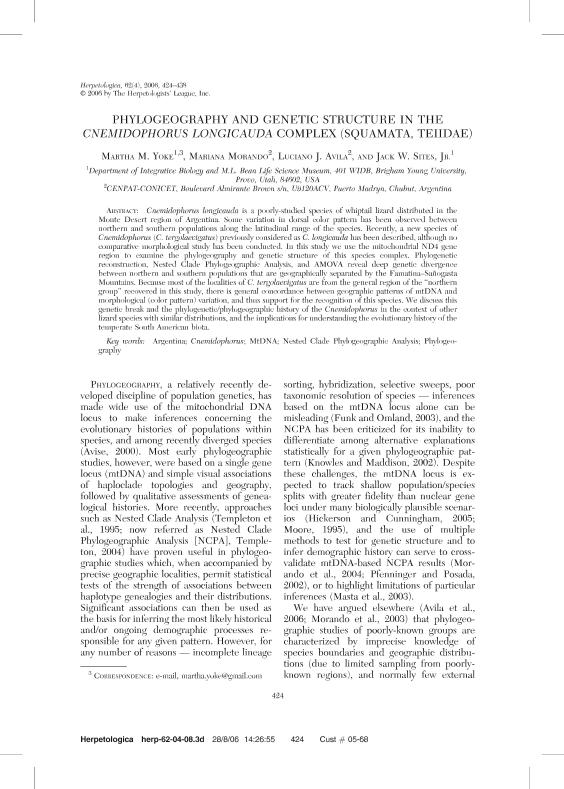Artículo
Phylogeography and genetic structure in the Cnemidophorus longicauda complex (Squamata, Teiidae)
Fecha de publicación:
12/2006
Editorial:
Herpetologists League
Revista:
Herpetologica
ISSN:
0018-0831
e-ISSN:
1938-5099
Idioma:
Inglés
Tipo de recurso:
Artículo publicado
Clasificación temática:
Resumen
Cnemidophorus longicauda is a poorly-studied species of whiptail lizard distributed in theMonte Desert region of Argentina. Some variation in dorsal color pattern has been observed between northern and southern populations along the latitudinal range of the species. Recently, a new species of Cnemidophorus (C. tergolaevigatus) previously considered as C. longicauda has been described, although no comparative morphological study has been conducted. In this study we use the mitochondrial ND4 gene region to examine the phylogeography and genetic structure of this species complex. Phylogenetic reconstruction, Nested Clade Phylogeographic Analysis, and AMOVA reveal deep genetic divergence between northern and southern populations that are geographically separated by the Famatina–San˜ogasta Mountains. Because most of the localities of C. tergolaevigatus are from the general region of the ‘‘northern group’’ recovered in this study, there is general concordance between geographic patterns of mtDNA and morphological (color pattern) variation, and thus support for the recognition of this species. We discuss this genetic break and the phylogenetic/phylogeographic history of the Cnemidophorus in the context of other lizard species with similar distributions, and the implications for understanding the evolutionary history of the temperate South American biota.
Archivos asociados
Licencia
Identificadores
Colecciones
Articulos(CCT-CENPAT)
Articulos de CTRO.CIENTIFICO TECNOL.CONICET - CENPAT
Articulos de CTRO.CIENTIFICO TECNOL.CONICET - CENPAT
Citación
Yoke, Martha M.; Morando, Mariana; Avila, Luciano Javier; Sites, Jack W.; Phylogeography and genetic structure in the Cnemidophorus longicauda complex (Squamata, Teiidae); Herpetologists League; Herpetologica; 62; 4; 12-2006; 420-434
Compartir
Altmétricas




